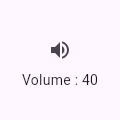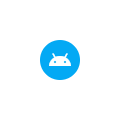// Copyright 2014 The Flutter Authors. All rights reserved.
// Use of this source code is governed by a BSD-style license that can be
// found in the LICENSE file.
import 'dart:math' as math;
import 'package:flutter/foundation.dart';
import 'package:flutter/widgets.dart';
import 'constants.dart';
import 'debug.dart';
import 'icons.dart';
import 'ink_well.dart';
import 'material.dart';
import 'theme.dart';
import 'theme_data.dart';
import 'tooltip.dart';
// Minimum logical pixel size of the IconButton.
// See: <https://material.io/design/usability/accessibility.html#layout-typography>.
const double _kMinButtonSize = kMinInteractiveDimension;
/// A material design icon button.
///
/// An icon button is a picture printed on a [Material] widget that reacts to
/// touches by filling with color (ink).
///
/// Icon buttons are commonly used in the [AppBar.actions] field, but they can
/// be used in many other places as well.
///
/// If the [onPressed] callback is null, then the button will be disabled and
/// will not react to touch.
///
/// Requires one of its ancestors to be a [Material] widget.
///
/// The hit region of an icon button will, if possible, be at least
/// kMinInteractiveDimension pixels in size, regardless of the actual
/// [iconSize], to satisfy the [touch target size](https://material.io/design/layout/spacing-methods.html#touch-targets)
/// requirements in the Material Design specification. The [alignment] controls
/// how the icon itself is positioned within the hit region.
///
/// {@tool dartpad --template=stateful_widget_scaffold_center}
///
/// This sample shows an `IconButton` that uses the Material icon "volume_up" to
/// increase the volume.
///
/// 
///
/// ```dart preamble
/// double _volume = 0.0;
/// ```
///
/// ```dart
/// Widget build(BuildContext context) {
/// return Column(
/// mainAxisSize: MainAxisSize.min,
/// children: <Widget>[
/// IconButton(
/// icon: Icon(Icons.volume_up),
/// tooltip: 'Increase volume by 10',
/// onPressed: () {
/// setState(() {
/// _volume += 10;
/// });
/// },
/// ),
/// Text('Volume : $_volume')
/// ],
/// );
/// }
/// ```
/// {@end-tool}
///
/// ### Adding a filled background
///
/// Icon buttons don't support specifying a background color or other
/// background decoration because typically the icon is just displayed
/// on top of the parent widget's background. Icon buttons that appear
/// in [AppBar.actions] are an example of this.
///
/// It's easy enough to create an icon button with a filled background
/// using the [Ink] widget. The [Ink] widget renders a decoration on
/// the underlying [Material] along with the splash and highlight
/// [InkResponse] contributed by descendant widgets.
///
/// {@tool dartpad --template=stateless_widget_scaffold}
///
/// In this sample the icon button's background color is defined with an [Ink]
/// widget whose child is an [IconButton]. The icon button's filled background
/// is a light shade of blue, it's a filled circle, and it's as big as the
/// button is.
///
/// 
///
/// ```dart
/// Widget build(BuildContext context) {
/// return Material(
/// color: Colors.white,
/// child: Center(
/// child: Ink(
/// decoration: const ShapeDecoration(
/// color: Colors.lightBlue,
/// shape: CircleBorder(),
/// ),
/// child: IconButton(
/// icon: Icon(Icons.android),
/// color: Colors.white,
/// onPressed: () {},
/// ),
/// ),
/// ),
/// );
/// }
/// ```
/// {@end-tool}
///
/// See also:
///
/// * [Icons], a library of predefined icons.
/// * [BackButton], an icon button for a "back" affordance which adapts to the
/// current platform's conventions.
/// * [CloseButton], an icon button for closing pages.
/// * [AppBar], to show a toolbar at the top of an application.
/// * [RaisedButton] and [FlatButton], for buttons with text in them.
/// * [InkResponse] and [InkWell], for the ink splash effect itself.
class IconButton extends StatelessWidget {
/// Creates an icon button.
///
/// Icon buttons are commonly used in the [AppBar.actions] field, but they can
/// be used in many other places as well.
///
/// Requires one of its ancestors to be a [Material] widget.
///
/// The [iconSize], [padding], [autofocus], and [alignment] arguments must not
/// be null (though they each have default values).
///
/// The [icon] argument must be specified, and is typically either an [Icon]
/// or an [ImageIcon].
const IconButton({
Key key,
this.iconSize = 24.0,
this.visualDensity,
this.padding = const EdgeInsets.all(8.0),
this.alignment = Alignment.center,
@required this.icon,
this.color,
this.focusColor,
this.hoverColor,
this.highlightColor,
this.splashColor,
this.disabledColor,
@required this.onPressed,
this.focusNode,
this.autofocus = false,
this.tooltip,
this.enableFeedback = true,
this.constraints,
}) : assert(iconSize != null),
assert(padding != null),
assert(alignment != null),
assert(autofocus != null),
assert(icon != null),
super(key: key);
/// The size of the icon inside the button.
///
/// This property must not be null. It defaults to 24.0.
///
/// The size given here is passed down to the widget in the [icon] property
/// via an [IconTheme]. Setting the size here instead of in, for example, the
/// [Icon.size] property allows the [IconButton] to size the splash area to
/// fit the [Icon]. If you were to set the size of the [Icon] using
/// [Icon.size] instead, then the [IconButton] would default to 24.0 and then
/// the [Icon] itself would likely get clipped.
final double iconSize;
/// Defines how compact the icon button's layout will be.
///
/// {@macro flutter.material.themedata.visualDensity}
///
/// See also:
///
/// * [ThemeData.visualDensity], which specifies the [density] for all widgets
/// within a [Theme].
final VisualDensity visualDensity;
/// The padding around the button's icon. The entire padded icon will react
/// to input gestures.
///
/// This property must not be null. It defaults to 8.0 padding on all sides.
final EdgeInsetsGeometry padding;
/// Defines how the icon is positioned within the IconButton.
///
/// This property must not be null. It defaults to [Alignment.center].
///
/// See also:
///
/// * [Alignment], a class with convenient constants typically used to
/// specify an [AlignmentGeometry].
/// * [AlignmentDirectional], like [Alignment] for specifying alignments
/// relative to text direction.
final AlignmentGeometry alignment;
/// The icon to display inside the button.
///
/// The [Icon.size] and [Icon.color] of the icon is configured automatically
/// based on the [iconSize] and [color] properties of _this_ widget using an
/// [IconTheme] and therefore should not be explicitly given in the icon
/// widget.
///
/// This property must not be null.
///
/// See [Icon], [ImageIcon].
final Widget icon;
/// The color for the button's icon when it has the input focus.
///
/// Defaults to [ThemeData.focusColor] of the ambient theme.
final Color focusColor;
/// The color for the button's icon when a pointer is hovering over it.
///
/// Defaults to [ThemeData.hoverColor] of the ambient theme.
final Color hoverColor;
/// The color to use for the icon inside the button, if the icon is enabled.
/// Defaults to leaving this up to the [icon] widget.
///
/// The icon is enabled if [onPressed] is not null.
///
/// ```dart
/// IconButton(
/// color: Colors.blue,
/// onPressed: _handleTap,
/// icon: Icons.widgets,
/// )
/// ```
final Color color;
/// The primary color of the button when the button is in the down (pressed) state.
/// The splash is represented as a circular overlay that appears above the
/// [highlightColor] overlay. The splash overlay has a center point that matches
/// the hit point of the user touch event. The splash overlay will expand to
/// fill the button area if the touch is held for long enough time. If the splash
/// color has transparency then the highlight and button color will show through.
///
/// Defaults to the Theme's splash color, [ThemeData.splashColor].
final Color splashColor;
/// The secondary color of the button when the button is in the down (pressed)
/// state. The highlight color is represented as a solid color that is overlaid over the
/// button color (if any). If the highlight color has transparency, the button color
/// will show through. The highlight fades in quickly as the button is held down.
///
/// Defaults to the Theme's highlight color, [ThemeData.highlightColor].
final Color highlightColor;
/// The color to use for the icon inside the button, if the icon is disabled.
/// Defaults to the [ThemeData.disabledColor] of the current [Theme].
///
/// The icon is disabled if [onPressed] is null.
final Color disabledColor;
/// The callback that is called when the button is tapped or otherwise activated.
///
/// If this is set to null, the button will be disabled.
final VoidCallback onPressed;
/// {@macro flutter.widgets.Focus.focusNode}
final FocusNode focusNode;
/// {@macro flutter.widgets.Focus.autofocus}
final bool autofocus;
/// Text that describes the action that will occur when the button is pressed.
///
/// This text is displayed when the user long-presses on the button and is
/// used for accessibility.
final String tooltip;
/// Whether detected gestures should provide acoustic and/or haptic feedback.
///
/// For example, on Android a tap will produce a clicking sound and a
/// long-press will produce a short vibration, when feedback is enabled.
///
/// See also:
///
/// * [Feedback] for providing platform-specific feedback to certain actions.
final bool enableFeedback;
/// Optional size constraints for the button.
///
/// When unspecified, defaults to:
/// ```dart
/// const BoxConstraints(
/// minWidth: kMinInteractiveDimension,
/// minHeight: kMinInteractiveDimension,
/// )
/// ```
/// where [kMinInteractiveDimension] is 48.0, and then with visual density
/// applied.
///
/// The default constraints ensure that the button is accessible.
/// Specifying this parameter enables creation of buttons smaller than
/// the minimum size, but it is not recommended.
///
/// The visual density uses the [visualDensity] parameter if specified,
/// and `Theme.of(context).visualDensity` otherwise.
final BoxConstraints constraints;
@override
Widget build(BuildContext context) {
assert(debugCheckHasMaterial(context));
final ThemeData theme = Theme.of(context);
Color currentColor;
if (onPressed != null)
currentColor = color;
else
currentColor = disabledColor ?? theme.disabledColor;
final VisualDensity effectiveVisualDensity = visualDensity ?? theme.visualDensity;
final BoxConstraints unadjustedConstraints = constraints ?? const BoxConstraints(
minWidth: _kMinButtonSize,
minHeight: _kMinButtonSize,
);
final BoxConstraints adjustedConstraints = effectiveVisualDensity.effectiveConstraints(unadjustedConstraints);
Widget result = ConstrainedBox(
constraints: adjustedConstraints,
child: Padding(
padding: padding,
child: SizedBox(
height: iconSize,
width: iconSize,
child: Align(
alignment: alignment,
child: IconTheme.merge(
data: IconThemeData(
size: iconSize,
color: currentColor,
),
child: icon,
),
),
),
),
);
if (tooltip != null) {
result = Tooltip(
message: tooltip,
child: result,
);
}
return Semantics(
button: true,
enabled: onPressed != null,
child: InkResponse(
focusNode: focusNode,
autofocus: autofocus,
canRequestFocus: onPressed != null,
onTap: onPressed,
enableFeedback: enableFeedback,
child: result,
focusColor: focusColor ?? Theme.of(context).focusColor,
hoverColor: hoverColor ?? Theme.of(context).hoverColor,
highlightColor: highlightColor ?? Theme.of(context).highlightColor,
splashColor: splashColor ?? Theme.of(context).splashColor,
radius: math.max(
Material.defaultSplashRadius,
(iconSize + math.min(padding.horizontal, padding.vertical)) * 0.7,
// x 0.5 for diameter -> radius and + 40% overflow derived from other Material apps.
),
),
);
}
@override
void debugFillProperties(DiagnosticPropertiesBuilder properties) {
super.debugFillProperties(properties);
properties.add(DiagnosticsProperty<Widget>('icon', icon, showName: false));
properties.add(StringProperty('tooltip', tooltip, defaultValue: null, quoted: false));
properties.add(ObjectFlagProperty<VoidCallback>('onPressed', onPressed, ifNull: 'disabled'));
properties.add(ColorProperty('color', color, defaultValue: null));
properties.add(ColorProperty('disabledColor', disabledColor, defaultValue: null));
properties.add(ColorProperty('focusColor', focusColor, defaultValue: null));
properties.add(ColorProperty('hoverColor', hoverColor, defaultValue: null));
properties.add(ColorProperty('highlightColor', highlightColor, defaultValue: null));
properties.add(ColorProperty('splashColor', splashColor, defaultValue: null));
properties.add(DiagnosticsProperty<EdgeInsetsGeometry>('padding', padding, defaultValue: null));
properties.add(DiagnosticsProperty<FocusNode>('focusNode', focusNode, defaultValue: null));
}
}